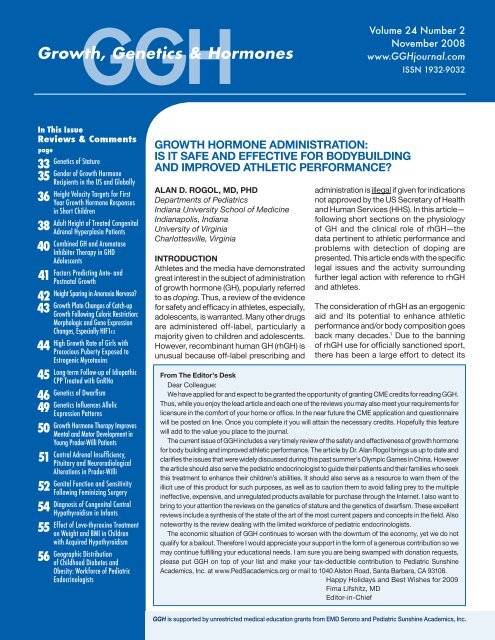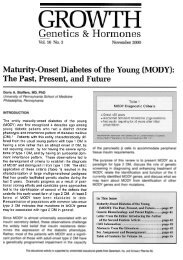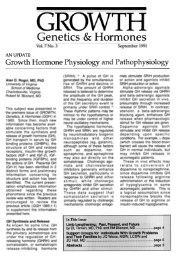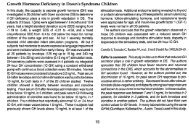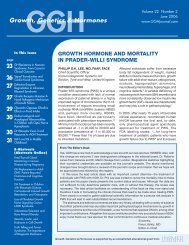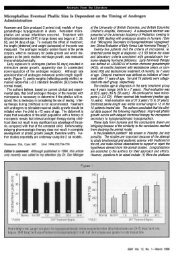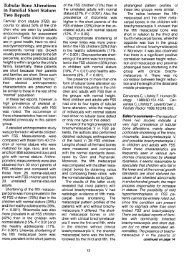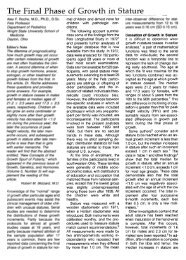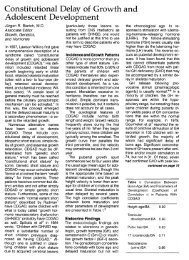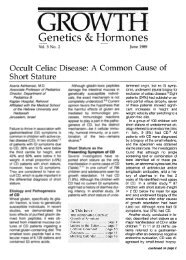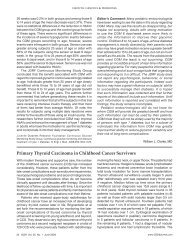Create successful ePaper yourself
Turn your PDF publications into a flip-book with our unique Google optimized e-Paper software.
<strong>GGH</strong><br />
Growth, Genetics & Hormones<br />
Volume 24 Number 2<br />
November 2008<br />
www.<strong>GGH</strong>journal.com<br />
ISSN 1932-9032<br />
In This Issue<br />
Reviews & Comments<br />
page<br />
33<br />
35<br />
36<br />
38<br />
40<br />
41<br />
42<br />
43<br />
44<br />
45<br />
46<br />
49<br />
50<br />
51<br />
52<br />
54<br />
55<br />
56<br />
Genetics of Stature<br />
Gender of Growth Hormone<br />
Recipients in the US and Globally<br />
Height Velocity Targets for First<br />
Year Growth Hormone Responses<br />
in Short Children<br />
Adult Height of Treated Congenital<br />
Adrenal Hyperplasia Patients<br />
Combined GH and Aromatase<br />
Inhibitor Therapy in GHD<br />
Adolescents<br />
Factors Predicting Ante- and<br />
Postnatal Growth<br />
Height Sparing in Anorexia Nervosa?<br />
Growth Plate Changes of Catch-up<br />
Growth Following Caloric Restriction:<br />
Morphologic and Gene Expression<br />
Changes, Especially HIF1a<br />
High Growth Rate of Girls with<br />
Precocious Puberty Exposed to<br />
Estrogenic Mycotoxins<br />
Long-term Follow-up of Idiopathic<br />
CPP Treated with GnRHa<br />
Genetics of Dwarfism<br />
Genetics Influences Allelic<br />
Expression Patterns<br />
Growth Hormone Therapy Improves<br />
Mental and Motor Development in<br />
Young Prader-Willi Patients<br />
Central Adrenal Insufficiency,<br />
Pituitary and Neuroradiological<br />
Alterations in Prader-Willi<br />
Genital Function and Sensitivity<br />
Following Feminizing Surgery<br />
Diagnosis of Congenital Central<br />
Hypothyroidism in Infants<br />
Effect of Levo-thyroxine Treatment<br />
on Weight and BMI in Children<br />
with Acquired Hypothyroidism<br />
Geographic Distribution<br />
of Childhood Diabetes and<br />
Obesity: Workforce of Pediatric<br />
Endocrinologists<br />
Growth Hormone Administration:<br />
Is it safe and effective for bodybuilding<br />
and improved athletic performance?<br />
Alan D. Rogol, MD, PhD<br />
Departments of Pediatrics<br />
Indiana University School of Medicine<br />
Indianapolis, Indiana<br />
University of Virginia<br />
Charlottesville, Virginia<br />
INTRODUCTION<br />
Athletes and the media have demonstrated<br />
great interest in the subject of administration<br />
of growth hormone (GH), popularly referred<br />
to as doping. Thus, a review of the evidence<br />
for safety and efficacy in athletes, especially,<br />
adolescents, is warranted. Many other drugs<br />
are administered off-label, particularly a<br />
majority given to children and adolescents.<br />
However, recombinant human GH (rhGH) is<br />
unusual because off-label prescribing and<br />
administration is illegal if given for indications<br />
not approved by the US Secretary of Health<br />
and Human Services (HHS). In this article—<br />
following short sections on the physiology<br />
of GH and the clinical role of rhGH—the<br />
data pertinent to athletic performance and<br />
problems with detection of doping are<br />
presented. This article ends with the specific<br />
legal issues and the activity surrounding<br />
further legal action with reference to rhGH<br />
and athletes.<br />
The consideration of rhGH as an ergogenic<br />
aid and its potential to enhance athletic<br />
performance and/or body composition goes<br />
back many decades. 1 Due to the banning<br />
of rhGH use for officially sanctioned sport,<br />
there has been a large effort to detect its<br />
From The Editor’s Desk<br />
Dear Colleague:<br />
We have applied for and expect to be granted the opportunity of granting CME credits for reading <strong>GGH</strong>.<br />
Thus, while you enjoy the lead article and each one of the reviews you may also meet your requirements for<br />
licensure in the comfort of your home or office. In the near future the CME application and questionnaire<br />
will be posted on line. Once you complete it you will attain the necessary credits. Hopefully this feature<br />
will add to the value you place to the journal.<br />
The current issue of <strong>GGH</strong> includes a very timely review of the safety and effectiveness of growth hormone<br />
for body building and improved athletic performance. The article by Dr. Alan Rogol brings us up to date and<br />
clarifies the issues that were widely discussed during this past summer’s Olympic Games in China. However<br />
the article should also serve the pediatric endocrinologist to guide their patients and their families who seek<br />
this treatment to enhance their children’s abilities. It should also serve as a resource to warn them of the<br />
illicit use of this product for such purposes, as well as to caution them to avoid falling prey to the multiple<br />
ineffective, expensive, and unregulated products available for purchase through the Internet. I also want to<br />
bring to your attention the reviews on the genetics of stature and the genetics of dwarfism. These excellent<br />
reviews include a synthesis of the state of the art of the most current papers and concepts in the field. Also<br />
noteworthy is the review dealing with the limited workforce of pediatric endocrinologists.<br />
The economic situation of <strong>GGH</strong> continues to worsen with the downturn of the economy, yet we do not<br />
qualify for a bailout. Therefore I would appreciate your support in the form of a generous contribution so we<br />
may continue fulfilling your educational needs. I am sure you are being swamped with donation requests,<br />
please put <strong>GGH</strong> on top of your list and make your tax-deductible contribution to Pediatric Sunshine<br />
Academics, Inc. at www.PedSacademics.org or mail to 1040 Alston Road, Santa Barbara, CA 93108.<br />
Happy Holidays and Best Wishes for 2009<br />
Fima Lifshitz, MD<br />
Editor-in-Chief<br />
<strong>GGH</strong> is supported by unrestricted medical education grants from EMD Serono and Pediatric Sunshine Academics, Inc.
GROWTH, GENETICS & HORMONES<br />
presence in athletes. 2,3 More than ten years and millions<br />
of dollars have been spent on devising and implementing<br />
tests to detect doping. Despite anecdotal reports of<br />
the widespread use of doping no athlete has been<br />
sanctioned for the use of rhGH, even with the multiple<br />
seizures of rhGH from athletes and teams.<br />
Why should pediatric endocrinologists be concerned about<br />
this seemingly esoteric subject? Pediatric endocrinologists<br />
have been counseling children, adolescents, and their<br />
parents about the height-increasing properties of rhGH for<br />
decades. The use of rhGH is legitimate in children who are<br />
truly small, such as those with GH deficiency, and other<br />
disorders (Table 1). As athletics and sports play an ever<br />
increasing and important role in the lives of children and<br />
adolescents, parents seek a competitive edge for their<br />
children. Families spend thousands of dollars on coaching<br />
and equipment in hopes of the possibilities of college<br />
scholarships and/or professional contracts. Therefore,<br />
pediatricians are now being asked to prescribe rhGH<br />
because of parental “beliefs” that it will improve athletic<br />
performance in children and adolescents. Although very<br />
expensive, parents may consider rhGH as seemingly little<br />
different from very expensive coaches, equipment, and<br />
training camps.<br />
Table 1. FDA-approved indications for rhGH therapy<br />
in children<br />
Growth hormone deficiency<br />
Chronic kidney disease<br />
Turner syndrome<br />
Small-for-gestational age infants who fail to catch-up to the<br />
normal growth percentiles<br />
Prader-Willi syndrome<br />
Idiopathic short stature<br />
SHOX gene haploinsufficiency<br />
Noonan syndrome<br />
Physiological role of gh<br />
The physiological role of GH is to increase linear<br />
growth in children, to promote anabolic (tissue building)<br />
metabolism, and to alter body composition as part of<br />
this anabolic role. Growth hormone actions include<br />
the hepatic and local synthesis and release of its main<br />
mediator-protein, insulin-like growth factor (IGF)-I. The<br />
growth-promoting effects of GH include longitudinal<br />
bone growth by actions at the epiphysis and the<br />
differentiation of the prechondrocytes. GH shares some<br />
of these roles with IGF-I, meaning that the direct effect of<br />
GH and/or local production of IGF-I are both necessary<br />
for optimal growth. 4<br />
Stimuli to GH release include deep sleep, exercise, stress—<br />
including heat stress—hypoglycemia, and some amino<br />
acids. Some pharmacological agents are also stimuli to<br />
the release of GH, for example, beta-2 adrenergic agonists,<br />
clonidine, L-DOPA, and estrogens and androgens (through<br />
an estrogen dependent mechanism). Inhibitory influences<br />
include obesity or ingesting a carbohydrate-rich diet. The<br />
direct effects of GH lead to increased glucose availability,<br />
increased free fatty acid levels and an increase in amino<br />
acid uptake by muscle. Longer term effects are mediated<br />
via IGF-I and include endocrine and paracrine effects in<br />
muscle and bone. 4<br />
Alterations in GH-deficient subjects include: the<br />
reduction of lean body mass, an increase in body fat, and<br />
a reduction in bone mineral density. From this the major<br />
metabolic effects of GH can be deduced. Administering<br />
rhGH reverses many of these alterations. However, it is<br />
not quite so simple, because GH has different effects<br />
depending upon the time following natural secretion<br />
(GH) or exogenous administration (rhGH). It is insulinlike<br />
in the first few minutes, but after several hours GH<br />
becomes diabetogenic and is anti-insulin at the liver<br />
and at peripheral sites, glucose utilization is decreased,<br />
lipolysis is increased, and the tissues are refractory to<br />
the acute insulin-like effects for several hours. The direct<br />
actions of GH include amino acid transport in muscle<br />
permitting protein synthesis and an increase in nitrogen<br />
balance, increased fat mobilization through lipolysis<br />
(increased triglyceride hydrolysis to free fatty acids and<br />
glycerol and reduction in fatty acid re-esterification)<br />
and an augmentation of lipid oxidation (Figure 1). These<br />
effects may be detected not only by decreases in body<br />
fat and in adipocyte size, but also by a decrease in lipid<br />
content per adipocyte. 4<br />
CLINICAL ROLE OF rhGH<br />
Short children are prescribed rhGH to promote linear<br />
growth 5 (Table 1) and that is the most visible result of<br />
rhGH treatment in infants, children, and adolescents.<br />
Additionally, rhGH prevents hypoglycemia in some<br />
infants with congenital hypopituitarism. In adults, rhGH is<br />
administered 6 to promote physiologic and psychological<br />
well-being (Table 2).<br />
Table 2. FDA-approved indications for rhGH<br />
therapy in adults<br />
Growth hormone deficiency<br />
Muscle wasting due to HIV/AIDS<br />
Short bowel syndrome<br />
The outcome of rhGH replacement therapy in a GHdeficient<br />
child or adolescent may be an increase in fatfree<br />
mass, both body cell mass (muscle) and total body<br />
water (especially the extra-cellular compartment), and a<br />
decrease in body fat with a redistribution from central<br />
to peripheral. 7 Controlled experiments in hypopituitary<br />
adults have shown that the baseline decrease in<br />
functional capacity of approximately 20% reverts to<br />
26 <strong>GGH</strong> Vol. 24, No. 2 November 2008 www.<strong>GGH</strong>journal.com
GROWTH, GENETICS & HORMONES<br />
normal when measured as maximal oxygen uptake<br />
(VO 2max<br />
), aerobic capacity, maximal power output, or<br />
ventilation threshold with rhGH treatment. 8,9 The increase<br />
in VO 2<br />
was proportionate to the increase in lean body<br />
mass (the respiring tissue). A decrease in fatigue was<br />
also reported; this is likely due to the decrease in the<br />
ventilatory threshold or lactate threshold as a percentage<br />
of maximal oxygen uptake. This was perceived as being<br />
able to work within a comfortable range.<br />
How might this happen? One should note that the<br />
requirements for the increase in work require metabolic<br />
fuels, oxidation (intermediary metabolism), and useable<br />
energy. The immediate burst comes from the oxidation<br />
of glucose and the more prolonged capacity from the<br />
oxidation of free-fatty acids. By increasing ventilation<br />
and oxygen transport by hemoglobin GH directly leads<br />
to an enhanced delivery of substrate and oxygen to<br />
respiring muscle. Increased cardiac output (stroke<br />
volume and left ventricular ejection fraction) permits the<br />
distribution of the oxygen to the capillary network and<br />
Figure 1. GH Replacement<br />
GH Replacement<br />
O2<br />
Increased red<br />
cell mass and<br />
plasma<br />
volume<br />
Glucose<br />
Liver<br />
O2<br />
Lungs<br />
Intestine<br />
Glucose<br />
IMTG<br />
Increased<br />
maximal oxygen<br />
uptake<br />
Blood<br />
Glycerol<br />
FFA<br />
Glucose<br />
Glucose<br />
FFA<br />
O2<br />
O2<br />
O2<br />
Mechanical Energy<br />
CO2 + H2O<br />
Heart<br />
Skeletal<br />
Muscle<br />
Adipose<br />
TG<br />
Glycerol<br />
+<br />
FFA<br />
to the extraction of the oxygen by muscle fibers, either<br />
to be used directly or stored in myoglobin. Other effects<br />
that enhance the delivery of oxygen include diminished<br />
systemic vascular resistance. In all of these physiologic<br />
responses GH and exercise are likely additive and,<br />
perhaps, synergistic. Indirect effects of GH (likely<br />
mediated by IGF-I) are related to the alteration in lean<br />
body mass and in more efficient thermoregulation.<br />
GH AND athletic performance<br />
In the 1940s the first GH was extracted from human<br />
cadaver pituitary glands. 10 The GH that was derived was<br />
in such limited quantities that there was none available for<br />
the purposes of testing it for athletic performance. 11 Only<br />
human and monkey pituitary GH has efficacy in man. 12,13<br />
In 1985 synthesized rhGH received FDA approval. Thus<br />
a virtually unlimited supply became available and clinical<br />
studies were undertaken in children and adolescents with<br />
subnormal growth and in adults with GH deficiency, aging,<br />
as well as for performance or aesthetic purposes. The<br />
evidence is neither clear nor robust that rhGH produces<br />
salutary ergogenic and performance<br />
benefits among athletes. 14<br />
Increased<br />
cardiac<br />
output<br />
Increased FFA<br />
release into and<br />
uptake from the<br />
circulation<br />
Increased<br />
exercise<br />
capacity<br />
Increased<br />
lipolysis<br />
Reprinted with permission Gibney J, et al. Endocr Rev. 2007;28:603-24. Copyright © Endocrine<br />
Society. 2007. All rights reserved.<br />
Definition of Doping<br />
The International Olympic Committee<br />
(IOC) defines doping as the “use of an<br />
expedient (substance or method) which<br />
is potentially harmful to athletes’ health<br />
and/or capable of enhancing their<br />
performance, or the presence in the<br />
athletes’ body of a prohibited substance<br />
or evidence of the use thereof or<br />
evidence of the use of a prohibited<br />
method”. There is no mention of intent<br />
or of how the substance entered the<br />
body. If the substance is in the athlete’s<br />
body then the athlete is responsible.<br />
That is the basis for sanctions for testing<br />
positive for a prohibited substance. Sir<br />
Arthur Porritt, first chairman of the IOC<br />
Medical Commission, noted, “To define<br />
doping is, if not impossible, at best<br />
extremely difficult, and yet everyone<br />
who takes part in competitive sport or<br />
who administers it knows exactly what<br />
it means. The definition lies not in words<br />
but in integrity of character.”<br />
In fact, there are huge pressures<br />
to excel. Athletes are driven to<br />
perform their best and along with<br />
the pressure to win there is often an<br />
attitude that doping is necessary to<br />
achieve success. Expectations about<br />
success include potentially lucrative<br />
financial rewards with winning, such<br />
www.<strong>GGH</strong>journal.com<br />
<strong>GGH</strong> Vol. 24, No. 2 November 2008 27
GROWTH, GENETICS & HORMONES<br />
as collegiate scholarships and salary as a professional<br />
athlete. The rationale for taking ergogenic effectors<br />
such as rhGH is that by becoming bigger and stronger<br />
the athlete will perform better. It should be noted<br />
that performance is much more than just strength or<br />
endurance; for the athlete must produce, control, and<br />
efficiently use the energy in a fashion that maximizes<br />
athletic performance.<br />
There is a system in place for therapeutic use exemptions<br />
to doping for those athletes who require the substance for<br />
health; for example, insulin is permissible for those with<br />
diabetes mellitus. This is a formal process overseen by<br />
the US Anti-Doping Agency (USADA) as the local agent<br />
for the world anti-doping effort as directed by the World<br />
Anti-Doping Agency (WADA).<br />
Abuse of rhGH<br />
The illegal indications for rhGH are listed in Table 3.<br />
Growth hormone is listed under class S2 of hormones<br />
and related substances in terms of the 2006 WADA<br />
and IOC prohibited list of doping agents. Other<br />
peptides in this category include erythropoietin (EPO),<br />
corticotrophin (ACTH), IGF-I, and insulin. It is likely<br />
that rhGH is being abused at an increasingly prevalent<br />
rate. However, it should be noted that much of what is<br />
purported to be rhGH—especially products promoted<br />
on the Internet—is not. Of course, any drug taken orally<br />
cannot be rhGH. Many of the products advertised<br />
online and in magazines are GH releasers, mainly<br />
amino acids and rarely, analogues of GH releasing<br />
hormone (GHRH). 15 It is also worth noting that these<br />
are considered “dietary supplements” and not subject<br />
to FDA oversight. The notion that amino acids release<br />
GH is on solid scientific ground given that tests for<br />
GH sufficiency may include arginine, or the closely<br />
related amino acid, ornithine. What isn’t stated is that<br />
very concentrated solutions of these amino acids are<br />
administered intravenously before GH is released. Also<br />
not prominent is the physiologic concept of the absolute<br />
and then relative refractory period following GH release,<br />
irrespective of the cause.<br />
Table 3. Off-label/illegal use of rhGH<br />
Anti-aging<br />
Athletic performance enhancement<br />
Body building<br />
A casual Internet search (in June, 2008) using the<br />
key words “hGH AND sport performance” yielded<br />
approximately 158,000 web links, mainly to sites that<br />
had multiple supplements to sell. Many of the listed<br />
products require administration for many months. A few<br />
examples included:<br />
• Chromium, l-ornithine, l-arginine, l-lysine, l-glutamine,<br />
l-glycine, “pituitary” powder, colostrums, placental<br />
extract and choline. 60-day supply $49.95<br />
• hGH energizer containing: vitamin B-6, tribulus,<br />
l-arginine, l-leucine, l-glutamine, l-lysine, gammaaminobutyric<br />
acid (GABA), l-isoleucine, l-valine,<br />
colostrums, l-ornithine and l-glycine. It is touted<br />
as an “all natural hGH supplement.” 90-day supply<br />
$29.95<br />
• A nasal spray. It contains: alpha GPL, GABA, multiple<br />
amino acids, many as noted above, l-DOPA, bean<br />
extract, momiyo extract and alpha-ketoglutarate—I<br />
suspect that many other substances are included!<br />
90 day supply $59.95<br />
Finally, something that might be rhGH for injection,<br />
but one must complete a form for a free (medical)<br />
consultation and thus presumably for a physician to<br />
write a prescription. It is important to note that if a<br />
prescription is written for anti-aging, body building, or<br />
athletic performance, a felony has been committed by the<br />
prescriber, the recipient, and (presumably) the dispenser<br />
(Table 3). Cost is not noted, but likely ranges in the $5,000<br />
to $50,000-range depending on the size of the recipient<br />
and the dose per kg.<br />
There are many reports that have noted an increasing<br />
prevalence of rhGH abuse. These primarily come from<br />
anecdotal “information” on the benefits of GH posted on<br />
the Internet, as well as a dated, but very favorable writeup<br />
in The Underground Steroid Handbook, 16 The press<br />
has reported an increasing number of seizures from elite<br />
athletes including cyclists and swimmers. What is it that<br />
athletes expect to obtain from taking rhGH? The athletes<br />
want improved performance, but such studies are difficult<br />
to do, either as alleged “clinical trials” or observational<br />
studies in athletes, for they rarely take agents singularly,<br />
but often a “cocktail” of multiple dietary supplements<br />
and one or more doping agents.<br />
Although rhGH has not been shown to unequivocally<br />
increase muscle strength or to improve performance, 14<br />
it is considered one of the drugs of choice, because it<br />
is extremely difficult to prove that one is receiving it.<br />
The structure of rhGH is identical to the main isoform<br />
of naturally secreted GH. The pulsatile secretion of<br />
native GH means that its levels fluctuate widely, from<br />
undetectable to clearly within the doping range. Both<br />
GH and rhGH have a short half-life in the circulation.<br />
Exercise is potent stimulus to GH release and release<br />
may be modified by variations in nutrition and legitimate<br />
nutritional supplements.<br />
Studies of rhGH in Athletes<br />
Liu and colleagues 14 have systematically reviewed the<br />
effects of rhGH on athletic performance. Using stringent<br />
criteria for a meta-analysis, they scanned 7599 titles<br />
from the largest databases, reviewed 252 abstracts in<br />
detail, and retrieved 56 articles for full-text evaluation.<br />
Following their review, 44 articles representing only 27<br />
28 <strong>GGH</strong> Vol. 24, No. 2 November 2008 www.<strong>GGH</strong>journal.com
GROWTH, GENETICS & HORMONES<br />
unique studies met the strict inclusion criteria. A total<br />
of 303 participants received rhGH for an average of 20<br />
days but a significant number received rhGH only once.<br />
The subjects were mainly young men (average age 27<br />
years) and were recreational and not elite athletes. The<br />
average dose was 36 µg/kg/day which is approximately<br />
5- to 10-fold the therapeutic dose for adults with GH<br />
deficiency. Lean body mass increased in the rhGHtreated<br />
groups compared to those not treated (2.1 kg<br />
[95% CI, 1.3 to 2.9 kg]) with a small, not statistically<br />
significant, decrease in fat mass (–0.9 kg [CI, –1.8 to –0.0<br />
kg]). Body weight did not change significantly. Only 2<br />
studies appropriately evaluated change in strength; 17,18<br />
these were the longest trials of 42 and 84 days duration.<br />
On 1-repetition maximum voluntary strength (1-RM)<br />
testing, those who received rhGH showed no change in<br />
biceps strength (–0.2 kg [CI, –1.5 to 1.1 kg]) or quadriceps<br />
strength (–0.1 kg [CI –1.8 to 1.5 kg]). In the second study<br />
none of the 7 other muscle groups evaluated showed a<br />
positive change in strength.<br />
Minor effects of rhGH have been noted on basal<br />
metabolism with a slight decrease in respiratory<br />
exchange rate reflecting the preferential burning of fat<br />
rather than carbohydrate, at rest. Additionally, very little<br />
effect on exercise capacity has been reported. The<br />
results may be summarized by noting that lactate levels<br />
trended higher, plasma free fatty acid concentrations and<br />
glycerol concentrations were significantly increased—<br />
reflecting the lipolytic metabolic effect of rhGH—but<br />
the respiratory exchange ratio did not change. These<br />
studies showed very little ergogenic effects of rhGH in<br />
recreational athletes. The studies were of short duration<br />
and most likely did not represent how elite athletes<br />
administer rhGH, either with reference to dose, duration<br />
of doping, or addition of other supplements—both legal<br />
and illegal. Based on countless reports in the media, it<br />
is clear that many athletes abuse steroids in addition to<br />
the noted amounts of rhGH. None of the studies would<br />
have been able to detect differences of 0.5 to 1.0 %<br />
in “performance”. These small differences are those<br />
that are relevant to the time (track) events, distance or<br />
height (field) events that separate the champion from<br />
any other finishing position. Similar issues relate to a<br />
host of sports other than track and field, but may be<br />
even more difficult to quantitate.<br />
Recently, rhGH (19 µg/kg/day) administered for one<br />
week was noted to increase strength, peak power<br />
output, and IGF-I levels in a group of abstinent<br />
dependent users of anabolic androgenic steroids. 19<br />
Great care was taken to be certain that no anabolic<br />
steroids were detected in appropriately obtained urine<br />
samples. Body weight increased—this was likely water<br />
retention—as did peak power output. Although this is<br />
a very special group of athletes and is a single study,<br />
it was quite carefully performed.<br />
Adverse events were common in the larger group of<br />
studies in the Liu et al meta analysis. 14 These mirrored<br />
those of adult subjects who administered rhGH in what<br />
were at that time, child and adolescent doses. Adverse<br />
events included soft tissue edema, joint pain, carpel tunnel<br />
syndrome, and excessive sweating. Most were related to<br />
fluid retention and considered to be secondary to the rhGH<br />
effects on salt and water balance by the kidney.<br />
In a clinical trial designed to determine the<br />
pharmacodynamics of rhGH abuse, Nelson and coworkers<br />
20 administered rhGH or placebo and testosterone<br />
(in men only) or placebo, or both in a double-blind study<br />
to young recreational athletes for 8 weeks. The final doses<br />
of rhGH were approximately 4-fold (women) and 6-fold<br />
(men) the normally prescribed dose for GH deficient<br />
young adults. Although there were no “efficacy” data with<br />
reference to body composition or athletic performance,<br />
the data are important with reference to adverse events.<br />
Although no subject discontinued the study due to<br />
adverse events related to rhGH, minor adverse events<br />
were reported in all groups, including the placebo groups.<br />
Swelling was reported in a greater number of rhGH<br />
subjects than placebo subjects (men: 67% versus 2.5%,<br />
P=0.02; women: 65% versus 31%, P=0.06). Subjects<br />
receiving rhGH reported more joint pain and pins and<br />
needles sensations; however, statistical significance was<br />
reached only in the men (P= 0.02 and P=0.03). These data<br />
show the relatively small “therapeutic” index for rhGH<br />
and likely have implications for those athletes purportedly<br />
administering much higher doses.<br />
In a clever sub-analysis of the placebo group, only<br />
reported in abstract form, 21 this group of investigators<br />
queried the placebo group about whether they were<br />
receiving active drug. The male athletes who believed<br />
that they were administered rhGH, even though they<br />
received the placebo, had both perceived improvement<br />
in performance measures and improvement in one of<br />
several measured indicators of physical performance.<br />
Although the study design 20 was not powered for this<br />
endpoint, it certainly does complicate the outcomes of<br />
trials with rhGH for performance endpoints.<br />
Virtually all studies reviewed by Liu and colleagues 14 had<br />
significant limitations. The major ones included:<br />
• Very few studies evaluated strength and exercise<br />
capacity<br />
• Small effects would not have been found<br />
• Short duration of the studies, many for only one<br />
dose<br />
• Doses of rhGH and other supplements are very likely<br />
different in the real world.<br />
Liu and colleagues concluded, “Claims regarding the<br />
performance-enhancing properties of growth hormone<br />
are premature and are not supported by our review of<br />
the literature. The limited published data evaluating the<br />
www.<strong>GGH</strong>journal.com<br />
<strong>GGH</strong> Vol. 24, No. 2 November 2008 29
GROWTH, GENETICS & HORMONES<br />
effects of growth hormone on athletic performance<br />
suggest that although growth hormone increases lean<br />
body mass in the short term, it does not appear to<br />
improve strength and may worsen exercise capacity.<br />
In addition, growth hormone in the healthy young is<br />
frequently associated with adverse events.” 14<br />
CURRENT DETECTION OF rhGH DOPING<br />
The ability to detect rhGH has been quite a difficult task for<br />
analytical chemists, because the amino acid sequence of<br />
rhGH is identical to that of the main GH isoform secreted<br />
by the pituitary; unlike other peptide hormones it has no<br />
N-linked glycosylation sites; its secretion is pulsatile with<br />
a short half-life (16 to 20 minutes); there are circulating<br />
GH-binding proteins; potential cross reactivity with other<br />
peptide hormones (eg, prolactin); and it is stimulated<br />
by exercise and stress. Blood sampling is required for<br />
all detection methods, because less than 0.1% may be<br />
found in the urine. Its renal secretion is poorly understood<br />
and greatly variable within and between subjects. 22<br />
The analytical approaches rely on immunoassays as<br />
opposed to the more established doping tests for anabolic<br />
steroids, which depend on GC/MS technology (Figure 2).<br />
There are 2 general approaches to detection of doping<br />
with rhGH. The first, (direct) approach measures the GH<br />
isoform composition by the differential immunoassay<br />
method. 23 For this approach one constructs pairs of<br />
antibodies whose primary focus is all of the isoforms of GH<br />
and a second set which is virtually restricted to the 22kD<br />
isoform—the one that is 100% of the rhGH. The first assay<br />
is called permissive (pituitary) and the second specific<br />
(recombinant). The rationale is that the more one takes of<br />
the rhGH (22kD), the less pituitary GH (especially, 20kD)<br />
Figure 2. Rationale for detection of hGH in plasma by the differential immunoassay approach<br />
22 kD<br />
monomeric<br />
hGH<br />
Specific<br />
22 kD monomeric<br />
hGH only<br />
20 kD<br />
monomeric<br />
hGH<br />
parameter analyzed is<br />
___________ [Specific]<br />
[Permissive]<br />
smaller than<br />
20 kD fragments<br />
of hGH<br />
Acidic<br />
modified<br />
hGH<br />
Permissive<br />
multiple isoforms<br />
of hGH<br />
will be secreted; implying that the ratio of the assay of the<br />
specific to the permissive will rise. As an example, the ratio<br />
rises from 0.6 to 1.5 in subjects administered rhGH, but<br />
this assay would only be valid within a few days of the last<br />
injection of rhGH. The validation of this technique requires<br />
knowledge (ie, testing) of the effects of exercise on the<br />
recombinant/pituitary ratio, an independent confirmatory<br />
test, knowledge of the window of opportunity, and data<br />
from athletes—both recreational and elite. This method<br />
is unable to detect doping 22 with pituitary derived GH<br />
or the abuse of the GH secretagogues, IGF-I itself or in<br />
combination with its major circulating binding protein,<br />
IGFBP-3 (IGF-I/IGFBP-3).<br />
The second is the indirect approach in which specific<br />
analytes dependent on GH (or IGF-I) are measured.<br />
Variables from the IGF system and collagen/bone have<br />
been chosen because they change markedly during<br />
rhGH administration and it appears that combinations<br />
of variables using discriminant functions are the most<br />
promising. Detection of rhGH supplementation is possible<br />
at least until 2 weeks following the last administration,<br />
although there is progressively decreasing sensitivity<br />
after the first week. Normative data in athletes have<br />
been established. 24 The physiological changes in GHdependent<br />
markers in adolescent athletes are far more<br />
dramatic than in older athletes, thus making it quite difficult<br />
to detect doping in this age range without constructing<br />
a complex algorithm that would depend more on<br />
maturational age than it would on the chronological<br />
age—another complication for doping control. 25,26 Data<br />
using this approach have noted only minor effects due<br />
to trauma or micro-injury or ethnic background. 3,27 As<br />
with any assay, rigorous standardization is required<br />
and interference by<br />
oligomers<br />
of<br />
hGH<br />
post<br />
translational<br />
modified hGH<br />
Adapted from Bidlingmaier M, Strasburger CJ. Nat Clin Pract Endocrinol Metab. 2007;3;769-77. Copyright ©<br />
NPG. 2007. All rights reserved.<br />
concomitant drug<br />
abuse, especially<br />
anabolic steroids, is<br />
a likely complication.<br />
For the moment the<br />
m o st info r mative<br />
c o m b i n a t i o n o f<br />
analytes is IGF-I and<br />
procollagen III peptide<br />
levels and individual<br />
discriminant functions<br />
for men and women.<br />
Future<br />
Research in<br />
Doping<br />
The dopingdetection<br />
field in the<br />
future will require<br />
the determination<br />
of combinations of<br />
r h G H - d e p e n d e n t<br />
30 <strong>GGH</strong> Vol. 24, No. 2 November 2008 www.<strong>GGH</strong>journal.com
GROWTH, GENETICS & HORMONES<br />
analytes that remain detectable for a longer period of<br />
time than the ones currently available, and perhaps other<br />
methods for the direct determination of the IGFs and<br />
GH-secretagogues. It would seem that abuse of rhGH<br />
(or other peptide hormones) manufactured by the major<br />
global pharmaceutical companies could be markedly<br />
diminished by adding, for example, an inert fluorescent<br />
marker that would be excreted in the urine. Detection of<br />
that unnatural marker might then be considered a doping<br />
offence. Most likely this would markedly diminish, but<br />
not stop, doping offences with these hormones. One<br />
can only speculate what is stopping the pharmaceutical<br />
manufactures from doing so.<br />
The era of gene doping, for example adding GH or IGF-I<br />
genes to specific muscles, is upon us. Experiments have<br />
been done in animals. 28 No detection methods presently<br />
available could detect this type of doping.<br />
LEGAL ISSUES<br />
As is true for most drugs, physicians may prescribe<br />
off-label, meaning that trials for that particular condition<br />
have not been performed but that it is logical to use an<br />
already approved drug for a specific patient. However,<br />
rhGH is quite different; it is illegal to prescribe rhGH<br />
off-label for age-related conditions (anti-aging) or for<br />
performance enhancement (Table 3). Unlike most FDAapproved<br />
medications, rhGH can only be prescribed<br />
for indications specifically authorized by the Secretary<br />
of HHS (for indications, see Table 1). Because it is not<br />
administered orally and it was formerly classified as a<br />
drug, rhGH is not considered a dietary supplement and<br />
is not subject to the Dietary Supplement and Health<br />
Education Act (DSHEA).<br />
The precise language of the Federal Drug and Cosmetic<br />
Act 29 (FDCA) under section 303 is:<br />
1. Except as provided in paragraph (2), whoever<br />
knowingly distributes, or possesses with intent to<br />
distribute, human growth hormone for any use in<br />
humans other than the treatment of a disease or<br />
other recognized medical condition, where such use<br />
has been authorized by the Secretary of Health and<br />
Human Services under section 505 and pursuant<br />
to the order of a physician, is guilty of an offense<br />
punishable by not more than 5 years in prison, such<br />
fines authorized by title 18, or both.<br />
2. Whoever commits any offense set forth in paragraph<br />
(1) and such offense involves an individual under 18<br />
years of age is punishable by not more than 10 years<br />
imprisonment, such fines as are authorized by title<br />
18 or both.<br />
3. Any conviction for a violation of paragraphs (1) and (2)<br />
of this subsection shall be considered a felony violation<br />
of the Controlled Substances Act for the purposes of<br />
forfeiture under section 413 of such Act.<br />
4. As used in this subsection the term “human growth<br />
5.<br />
hormone” means somatrem, somatropin, or an<br />
analogue of either of them.<br />
The Drug Enforcement Administration (DEA) is<br />
authorized to investigate offenses punishable by<br />
this subsection.<br />
SUMMARY AND CONCLUSIONS<br />
There are a number of legitimate uses of rhGH in infants,<br />
children, adolescents, and adults. It is different from<br />
most drugs in that its off-label use is illegal for those<br />
unapproved indications related to athletic performance,<br />
body building and anti-aging. Although difficult to show<br />
any ergogenic advantage in clinical trials, none of the<br />
trials have been large enough or have narrow enough<br />
end points to have a valid outcome given the changes<br />
in performance that are relevant to world-class athletes.<br />
Some progress is being made in the ability to detect<br />
doping with rhGH, but to date no national or international<br />
athlete has been sanctioned for abusing rhGH. This does<br />
not mean that rhGH is not being used by athletes, just<br />
that the testing is not yet robust enough to capture those<br />
abusing rhGH. Further research is clearly needed to<br />
improve the detection techniques, and also to determine<br />
if rhGH as administered to athletes is actually ergogenic<br />
or enhances one’s image in body building.<br />
As difficult as it is to note either changes in performance<br />
or body composition in adults, it is much more difficult<br />
to detect these alterations in adolescent athletes, whose<br />
natural pubertal progression involves a marked rampingup<br />
of the GH/IGF-I system, as well as the analytes that<br />
are being considered for the detection of doping.<br />
References<br />
1. Sonksen PH, Holt RI. Commentary on physical effects of short-term<br />
rhGH administration in abstinent steroid dependency. Horm Res.<br />
2008;69:355-6.<br />
2. Powrie JK, Bassett EE, Tosen T, et al, on behalf of the GH-2000 Project<br />
Study Group. Detection of growth hormone abuse in sport. Growth<br />
Horm IGF Res. 2007;17:220-6.<br />
3. Gibney J, Healy ML, Sonksen PH. The growth hormone/insulinlike<br />
growth factor-I axis in exercise and sport. Endocr Rev.<br />
2007;28:603-24.<br />
4. Melmed S, Kleinberg D. Anterior pituitary. In: Kronenberg HM, Melmed<br />
S, Polonsky KS, Larsen PR,eds. Williams Textbook of Endocrinology,<br />
edition 11. New York, NY: Saunders; 2007:155-261.<br />
5. Quigley CA. Growth hormone therapy of non-growth hormone<br />
deficient growth disorders. Endocrinol Metab Clin North Am.<br />
2007;36:131-86.<br />
6. Ho KK. GH deficiency Consensus Workshop Guidelines: Consensus<br />
guidelines for the diagnosis and treatment of adult with GH<br />
deficiency II: a statement of the GH research Society in association<br />
with the European Society for Paediatric Endocrinology, the<br />
Lawson Wilkins Pediatric Endocrine Society, Japan Endocrine<br />
Society, and the Endocrine Society of Australia. Eur J Endocrinol.<br />
2007;157:695-700.<br />
7. Roemmich JN, Huerta MG, Sundaresan SM, Rogol AD. Alterations<br />
in body composition and fat distribution in growth hormone deficient<br />
prepubertal children during growth hormone therapy. Metabolism.<br />
2001;50:537-47.<br />
8. Clayton P, Gleeson H, Monson J, Popovic V, Shalet SM, Christiansen<br />
JS. Growth hormone replacement throughout life: insights<br />
www.<strong>GGH</strong>journal.com<br />
<strong>GGH</strong> Vol. 24, No. 2 November 2008 31
GROWTH, GENETICS & HORMONES<br />
into age-related response to therapy. Growth Horm IGF Res.<br />
2007;17:369-82.<br />
9. Sherlock M, Toogood AA. Aging and the GH/insulin like growth factor-I<br />
axis. Pituitary. 2007;10:189-203.<br />
10. Blizzard RJ. Growth hormone as a theraeutic agent. Growth Genet<br />
Horm. 2005:21;49-54.<br />
11. Li CH, Papkoff H. Preparation and properties of growth hormone from<br />
human and monkey pituitary glands. Science. 1956;124:1293-4.<br />
12. Knobil E, Hotchkiss J. Growth hormone. Ann Rev Physiology.<br />
1964;26:47-74.<br />
13. Knobil E, Greep RO. The physiology of growth hormone with particular<br />
reference to its action in the rhesus monkey and the “species<br />
specificity” problem. Rec Progr Horm Res. 1959;15:1-69.<br />
14. Liu H, Bravata DM, Okin I, et al. Systematic review: the effects of growth<br />
hormone on athletic performance. Ann Int Med. 2008;144:747-58.<br />
15. Saugy M, Robinson N, Saudan C, Baume N, Avois L, Mangin. Human<br />
growth hormone doping in sport. Br J Sports Med. 2006;40:35-9.<br />
16. Duchaine D. The Original Underground Steroid Handbook, 1981.<br />
17. Deyssig R, Frisch H, Blum WF, Waldhör T. Effect of growth hormone<br />
treatment on hormonal parameters, body composition and strength<br />
in athletes. Acta Endocrinol (Copenh). 1993;128:313-8.<br />
18. Yarasheski KE, Campbell JA, Smith K, Rennie ML, Holloszy JO, Bier<br />
DM. Effect of growth hormone and resistance exercise on muscle<br />
growth in young men. Am J Physiol. 1992;262:E261-7.<br />
19. Graham MR, Baker JS, Evans P, et al. Physical effect of short-term<br />
recombinant human growth hormone administration in abstinent<br />
steroid dependency. Horm Res. 2008;69:343-54.<br />
20. Nelson AE, Meinhardt U, Hansen JL, et al. Pharmacodynamics of<br />
growth hormone abuse biomarkers and the influence of gender<br />
and testosterone: a randomized double-blind placebo-controlled<br />
study in young recreational athletes. J Clin Endocrinol Metab.<br />
2008;93:2213-22.<br />
21. Hansen JL, Nelson AE, Meinhardt U, Walker IH, Ho KK. The power<br />
of the mind: an evaluation of the placebo effect in a study of growth<br />
hormone on physical performance. Annual Meeting of The Endocrine<br />
Society, June 2008, San Francisco [Abstract].<br />
22. Holt RI, Sönksen PH. Growth hormone, IGF-I and insulin and their<br />
abuse in sport. Brit J Pharmacol. 2008;1-15.<br />
23. Bidlingmaier M, Strasburger CJ. Technology insight: detecting<br />
growth hormone abuse in athletes. Nat Clin Pract Endocinol Metab.<br />
2007;3:769-77.<br />
24. Healy ML, Dall R, Gibney J, et al. Toward the development of a test for<br />
growth hormone (GH) abuse: a study of extreme physiological ranges<br />
of GH-dependent markers in 813 elite athletes in the post-competition<br />
setting. J Clin Endocrinol Metab. 2005;90:641-9.<br />
25. Mora S, Pitukcheewanont P, Kaufman FR, Nelson JC, Gilsanz V.<br />
Biochemical markers of bone turnover and the volume and the density<br />
of bone in children at different stages of sexual development. J Bone<br />
Miner Res .1999;14:1664-71.<br />
26. Rauchenzauner M, Schmid A, Heinz-Erian P, et al. Sex- and agespecific<br />
reference curves for serum markers of bone turnover in<br />
healthy children from 2 months to 18 ears. J Clin Endocrinol Metab.<br />
2007;92:443-9.<br />
27. Erotokritou-Mulligan I, Bassett EE, Kniess A, Sönksen PH, Holt RI.<br />
Validation of the growth hormone (GH)-dependent marker method<br />
of detecting GH abuse in sport through the use of independent data<br />
sets. Growth Horm IGF Res. 2007;17:416-23.<br />
28. Barton-Davis ER, Shoturma DI, Musaro A, Rosenthal N, Sweeney<br />
HL. Viral mediated expression of insulin-like growth factor I blocks<br />
the aging-related oss of skeletal muscle function. Proc Natl Acad Sci<br />
USA. 1998;95:15603-7.<br />
29. US Food and Drug Administration. Federal Food, Drug and Cosmetics<br />
Act, Section 303. Penalties. Subsection (e)http://www.fda.gov/<br />
opacom/laws/fdcact/fdcact3.htm<br />
Editor’s Comment:<br />
The lead article in this issue of <strong>GGH</strong> entitled “Growth<br />
Hormone Administration: Is it safe and effective for<br />
bodybuilding and improved athletic performance?”<br />
by Dr. Alan Rogol reviews the current state of the<br />
misguided use of human growth hormone. This topic<br />
has been of high interest as prominent professional<br />
athletes have been the subject of investigation and<br />
hearings by the US Congress. These high profile<br />
governmental activities may only be reflecting the tip<br />
of the iceberg of a prevalent practice in our society<br />
that may be permeating our youth. It is not possible<br />
to track the number of individuals receiving illegally<br />
distributed growth hormone, but it may account for a<br />
$2 billion per year business in the US. 1 This is primarily<br />
a cash only business as the vast majority of users pay<br />
out of pocket for the drug. The New York State Bureau<br />
of Narcotic Enforcement uncovered highly profitable,<br />
illegal distribution of growth hormone; an investigated<br />
compounding pharmacy purchased 25 grams of<br />
imported growth hormone for $75,000 and converted<br />
each gram into 3000 IUs of growth hormone, then sold<br />
the drug for $6 to $18 per IU—yielding $450,000 to<br />
$1,350,000. 2 In 2007, in this case alone, the company<br />
entered into a deferred prosecution agreement with<br />
the Massachusetts US Attorney’s Office and was<br />
fined $10.5 million over the illegal distribution of<br />
growth hormone for non medical uses. Additionally,<br />
there are many other sales through the Internet of<br />
multiple products purportedly marketed as growth<br />
hormone. These practices preclude the detection and<br />
monitoring of adverse events and the potential health<br />
consequences of the illegal use of growth hormone.<br />
Pediatric endocrinologists are well acquainted with<br />
the wish of children and their parents to administer<br />
growth hormone for growth augmentation purposes<br />
and are often consulted for its use as an agent<br />
for enhancement of their athletic capability and<br />
bodybuilding. Beware that the administration of growth<br />
hormone for the later purpose is illegal and its efficacy<br />
and safety for bodybuilding and athletic performance<br />
has not been demonstrated, as discussed in the lead<br />
article by Rogol. However, as long as our culture seeks<br />
perceived physical enhancements with products like<br />
growth hormone, we will have to be aware of the<br />
extensive distribution and promotion to our youth and<br />
actively participate in curtailing its use. This is quite<br />
a challenge, as this and other medications are easily<br />
found and sold online. According to The New York<br />
Times 3 there are over 365 Internet sites that advertise<br />
and/or sell controlled medications by mail and offering<br />
to supply the drugs without a proper prescription.<br />
The US Drug Enforcement Administration found<br />
that 85% of all Internet prescription sales involved<br />
controlled drugs, compared with 11% of those filled<br />
through traditional pharmacies, suggesting that online<br />
32 <strong>GGH</strong> Vol. 24, No. 2 November 2008 www.<strong>GGH</strong>journal.com
GROWTH, GENETICS & HORMONES<br />
sales are destined for misuse. Mr. Califano, a former<br />
secretary of Health and Human Services, said: “Abuse<br />
of prescription drugs has exploded among college<br />
students, and we think that one way they get these<br />
drugs is over the Internet.”<br />
Fima Lifshitz, MD<br />
Editor-in-Chief<br />
References<br />
1. 110th US Congress Committee on Oversight and Government<br />
Reform. Hearing on myths and facts about growth hormone, B12<br />
and other substances. February 12, 2008.<br />
2. Quinn TJ. Specialty distribution systems helps feds after steroid<br />
bust. New York Daily News. September 1, 2007.<br />
3. Eckholm E. Abuses are found in online sales of medication. The<br />
New York Times. July 9, 2008. A16.<br />
Genetics of Stature<br />
REVIEWS & COMMENTS FROM THE LITERATURE<br />
Adult height is primarily (approximately 80% to 90%)<br />
determined by hereditary factors. Socioeconomic status,<br />
nutrition, and disease influence only a relatively small<br />
proportion of attained stature. It has long been suspected<br />
that there are a multitude of genes that impact upon this<br />
polygenic trait, with each gene exerting an additive but<br />
only very limited effect. From genome-wide association<br />
studies employing single nucleotide polymorphism<br />
(SNP) analyses in approximately 80,000 individuals of<br />
European ancestry (UK, Scandinavia, Holland, Iceland),<br />
these 3 investigative groups have identified more than<br />
30 chromosomal sites and the potential genes that<br />
appear to be partially involved in the regulation of adult<br />
stature in humans (Table). Gudbjartsson et al divided<br />
the candidate genes into 3 functional groups—those<br />
associated with skeletal development (eg, BMP2, BMP6),<br />
those that encode zinc-dependent metalloproteinases<br />
(ADAMTS10) and glycoproteins (eg, FBN1) that affect<br />
cartilage composition, and those that are involved<br />
with the processes of chromosome segregation and<br />
mitosis (eg, CDK6, HMGA2). The gene most frequently<br />
associated with stature in all 3 studies was ZBTB38. This<br />
zinc-finger protein binds methylated DNA—specifically<br />
the methylated allele of the differentially methylated region<br />
of H19/IGF2. 1 This is the site at which epigenetic errors<br />
of imprinting result in either the Beckwith-Wiedemann<br />
syndrome (OMIM 130650) of somatic overgrowth or the<br />
growth retardation syndrome of Russell-Silver (OMIM<br />
180860). 2 ZBTB38 represses transcription of methylated<br />
regions. Thus, it is interesting to speculate that ZBTB38<br />
might affect adult stature through regulation of the<br />
production of insulin-like growth factor (IGF)-II, perhaps<br />
during in utero development when IGF-II is known to be<br />
one of the determinants of fetal growth. Independent of<br />
its effect on methylated DNA, ZBTB38 also regulates<br />
transcription of TH, the gene encoding tyrosine<br />
hydroxylase, the rate-limiting step in catecholamine<br />
synthesis. Other commonly identified gene candidates<br />
were HMGA2 encoding a chromatin architectural factor<br />
and CDK6 encoding a cyclin dependent kinase regulator<br />
of the cell cycle.<br />
While each of these candidate genes has only a small<br />
effect upon adult height (estimated 0.4 cm), collectively<br />
they can exert significant influence and account for<br />
only approximately 4% of adult stature. The more “tall”<br />
alleles one has, the taller the individual (Figure). In the<br />
study of Weedon et al, there was a 5 cm difference in<br />
adult stature between subjects with 17 or fewer “tall”<br />
alleles compared to those with 27 or more.<br />
Gudbjartsson DF, Walters GB, Thorleifsson G, et al. Many sequence<br />
variants affecting diversity of adult human height. Nat Genet.<br />
2008;40:609-15.<br />
Lettre G, Jackson AU, Gieger C, et al. Identification of 10 loci associated<br />
with height highlights new biological pathways in human growth. Nat<br />
Genet. 2008;40:489-90.<br />
Weedon MN, Lango H, Lindgren CM, et al. Genome-wide association<br />
analysis identifies 20 loci that influence adult height. Nat Genet.<br />
2008;40:573-83.<br />
First Editor’s Comment: These reports are of great<br />
interest as they dramatically illustrate just how many<br />
genes must be involved in the determination of adult<br />
stature. They also illustrate the quantitative problem<br />
that the clinician will face in identifying the “cause” of<br />
genetic short stature in a specific patient. However, it was<br />
difficult to critically examine the data because some of<br />
it was derived by meta-analysis of previously published<br />
reports. Thus, it was unclear whether or not there may<br />
have been some overlap between analytical data utilized<br />
in the 3 reports. The reports are also difficult to interpret<br />
because the investigators employed different probes for<br />
similar or related SNP sites. For example, ZBTB38 was<br />
identified as SNP rs724016 in the report of Lettre et al,<br />
as SNP rs6440003 in the report of Weedon et al, and as<br />
SNP rs6763931 in the report of Gudbjartsson et al. [A brief<br />
expository review of genome-wide association studies and<br />
SNPs has been written by Christensen and Murray. 3 ]<br />
Allen W. Root, MD<br />
Second Editor’s Comment: Fisher proposed in 1918<br />
that many genetic factors, each having an individually<br />
www.<strong>GGH</strong>journal.com<br />
<strong>GGH</strong> Vol. 24, No. 2 November 2008 33


